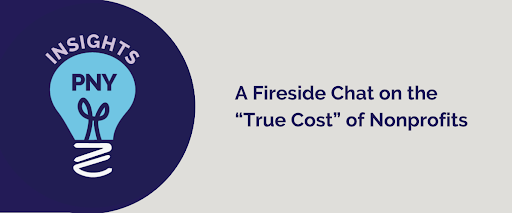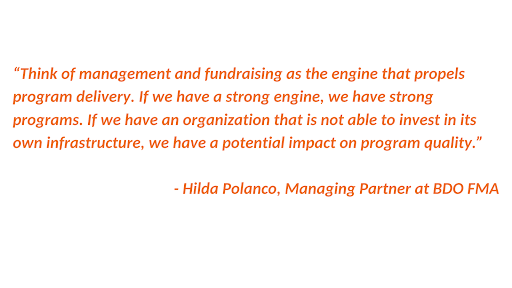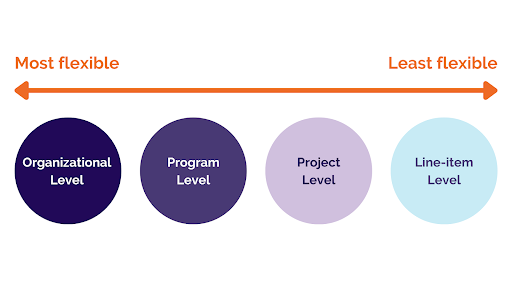Insights from “A Fireside Chat on the ‘True Costs’ of Nonprofits”
Have you heard of the “nonprofit starvation cycle"? According to The Bridgespan Group, this term refers to “the experience of many nonprofit organizations and NGOs that struggle financially because much of their funding comes from project grants with strict limits on paying for overhead or indirect costs.” In order to end the cycle, funders need to better understand the true costs involved in the effective management of a nonprofit.
In a rich discussion led by David S. Cohen, CEO of Doc Wayne Youth Services, Katie Tetrault, Vice President of Finance and Grants Management at The Annie E. Casey Foundation, and Hilda Polanco, Managing Partner at BDO FMA, funders identified concrete ways to realistically meet nonprofits where they are.
Along with exploring the definition of true costs, the group discussed how to practice equitable grantmaking policies and shared effective approaches to combating the nonprofit starvation cycle. Learn more here.
Grantmaking Approaches
More equitable grantmaking that encompasses the ‘true costs’ of nonprofits starts with understanding the different levels of grantmaking. There are four main levels of grants:
- Organizational level - Funding at the organizational level involves supporting or investing in an organization as a whole. How the funds are spent is left to the organization itself to determine. This is considered the most flexible type of funding. This is sometimes known as general operating or unrestricted support.
- Program level - Funding at the program level focuses on funding a specific program but leaves it to senior leadership within the nonprofit to determine how those dollars are spent.
- Project level - Funding at the project level includes providing funding for a specific project with a defined project scope. Often, project grants cannot be used for overhead or indirect costs.
- Line-item level - Funding at the line-item level is the most restrictive type of funding, as it only provides funding for specified project budget items. Government grants are a common example of line-item level grants.
While providing grants at the organizational level is considered the most flexible and ideal funding, most funding currently occurs at the program, project, or line-item level. Even if a funder isn’t able to transition directly to grantmaking at the organizational level, they can still make a difference in how they support nonprofits by shifting grants
towards the more flexible project or program level grantmaking.
Understanding Nonprofit Expenses
In addition to recognizing the different types of grantmaking approaches, it is important for funders to understand a nonprofit’s budget and recognize ‘true costs'. One simple way to think about expenses is to break them into direct program expenses and indirect program expenses:
- Direct program expenses are specific to a particular program and are incurred for this alone. These can also be thought of as ‘non-negotiable’ expenses and can include direct program salaries, rent, utility, and technology.
- Indirect expenses include expenses that are not easily traced to one program, such as administration and fundraising, which are essential and yet frequently restricted in grantmaking. These can include general operations, non-program staff, professional development, monitoring, and evaluation.
In some ways, the nonprofit model can be likened to a car, in which overhead would be the fuel and the administration and infrastructure would be the engine. A strong engine needs fuel to run, and a car needs a strong engine in order to go fast. The same applies to nonprofits; establishing a strong administration and infrastructure necessitates overhead spending, and strong programs are only possible with a strong administration and infrastructure.
How Funders Can Help
Many foundations currently have a flat indirect-cost policy of around 15 percent of direct costs. However, research shows that smaller organizations tend to have higher indirect cost rates than larger organizations due to the economies of scale achieved at larger organizations. Since organizations made up predominantly of BIPOC (Black, Indigenous, and people of color) staff and leaders are on average smaller than other organizations due to systemic funding barriers, it’s no surprise that most organizations led by leaders of color end up having higher indirect cost rates than non-organizations of color. Thus, flexibility is key to ensuring equity in grantmaking.
One way funders can help end the “nonprofit starvation cycle” is by adopting a tiered indirect cost rate structure, similar to that of The Annie E. Casey Foundation. Before reforming their indirect cost rate policies, the foundation had a flat overhead cap of 10%. After realizing this number was too low, the foundation not only decided to increase their overhead cap to 15%, but they implemented a tiered rate structure that allotted higher overhead rates to smaller organizations.
Another way funders can help bridge the funding gap is by offering multi-year grants. Due to the smaller, programmatic nature of many grants, many nonprofits find themselves continually scrambling for small grants in order to sustain themselves. This makes it difficult to plan for the future or invest in an organization’s growth. Offering multi-year grants is especially helpful to smaller nonprofits, as it allows them to plan for the future knowing they will have support down the line.
Another important consideration that funders must keep in mind when designing grants is inflation. Fixed price grants don’t account for the rising cost of living or the rising minimum wage. By factoring inflation into the equation, funders can gain a better sense of the true cost of nonprofits.
Conclusion:
Recognizing and addressing funders’ expectations about how much it really costs to run a nonprofit is the first step to ending the “nonprofit starvation cycle”. Understanding the true cost of nonprofits allows funders to give out grants that meet grantees’ true costs and needs. Not only does this strengthen grantees by helping them attract and retain staff, but it also allows grantees to invest in better infrastructure so they can run high-impact and sustainable programs.
Change starts with shifting how we think about grantmaking and having open conversations with grantees about what they really need and how best we can support them. Flexible and equitable grantmaking is essential to moving philanthropy forward and empowering both nonprofits and the communities that they serve.
Additional Resources:




